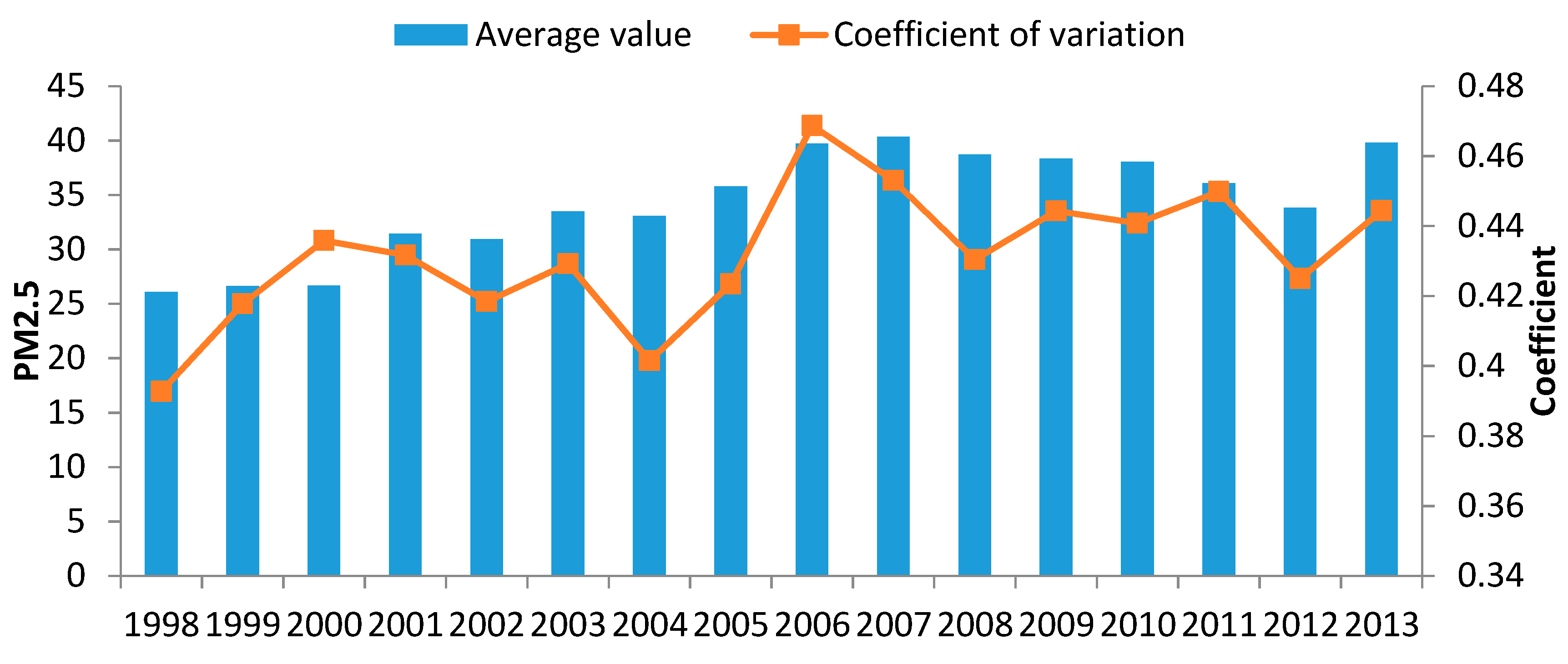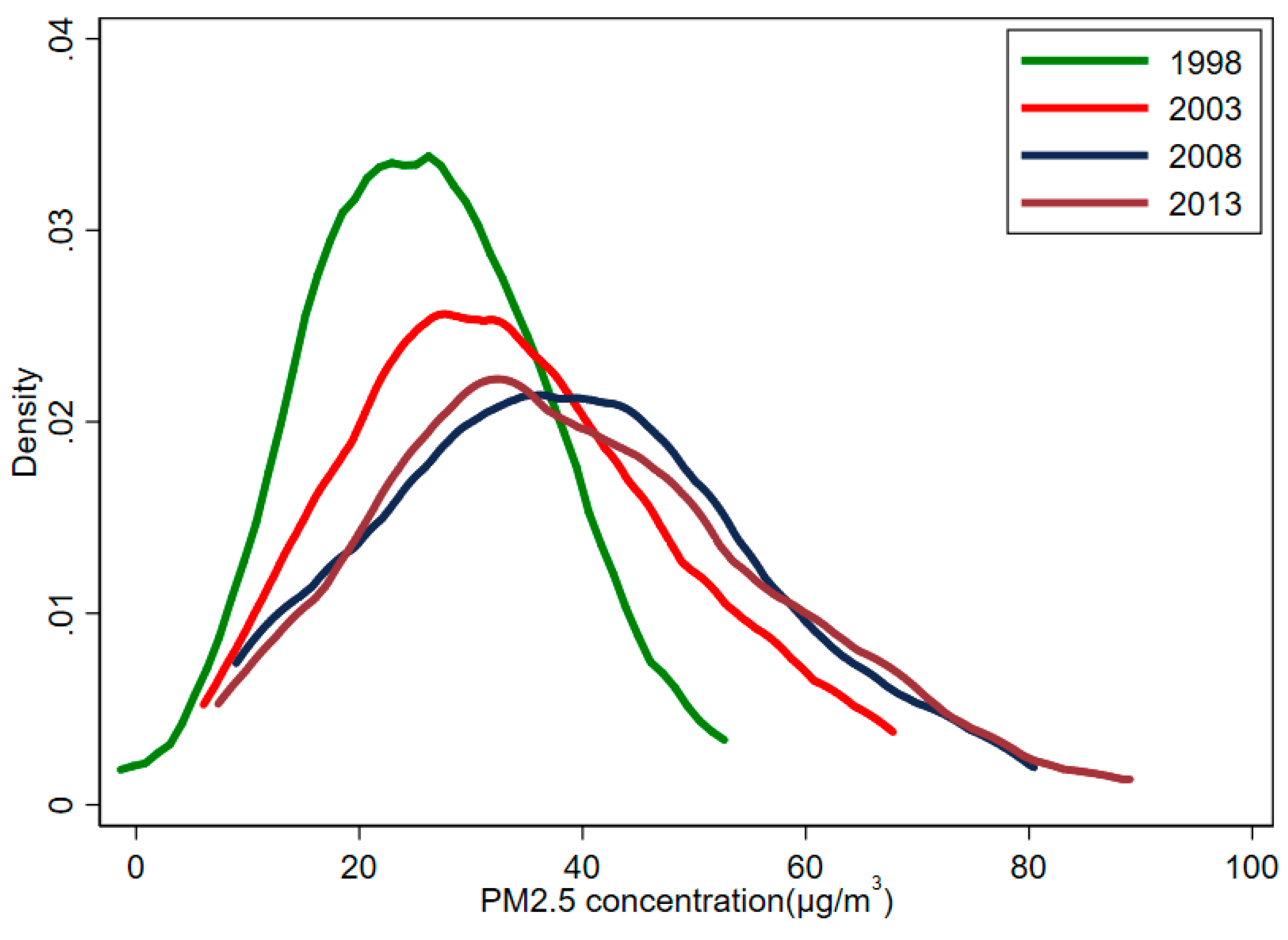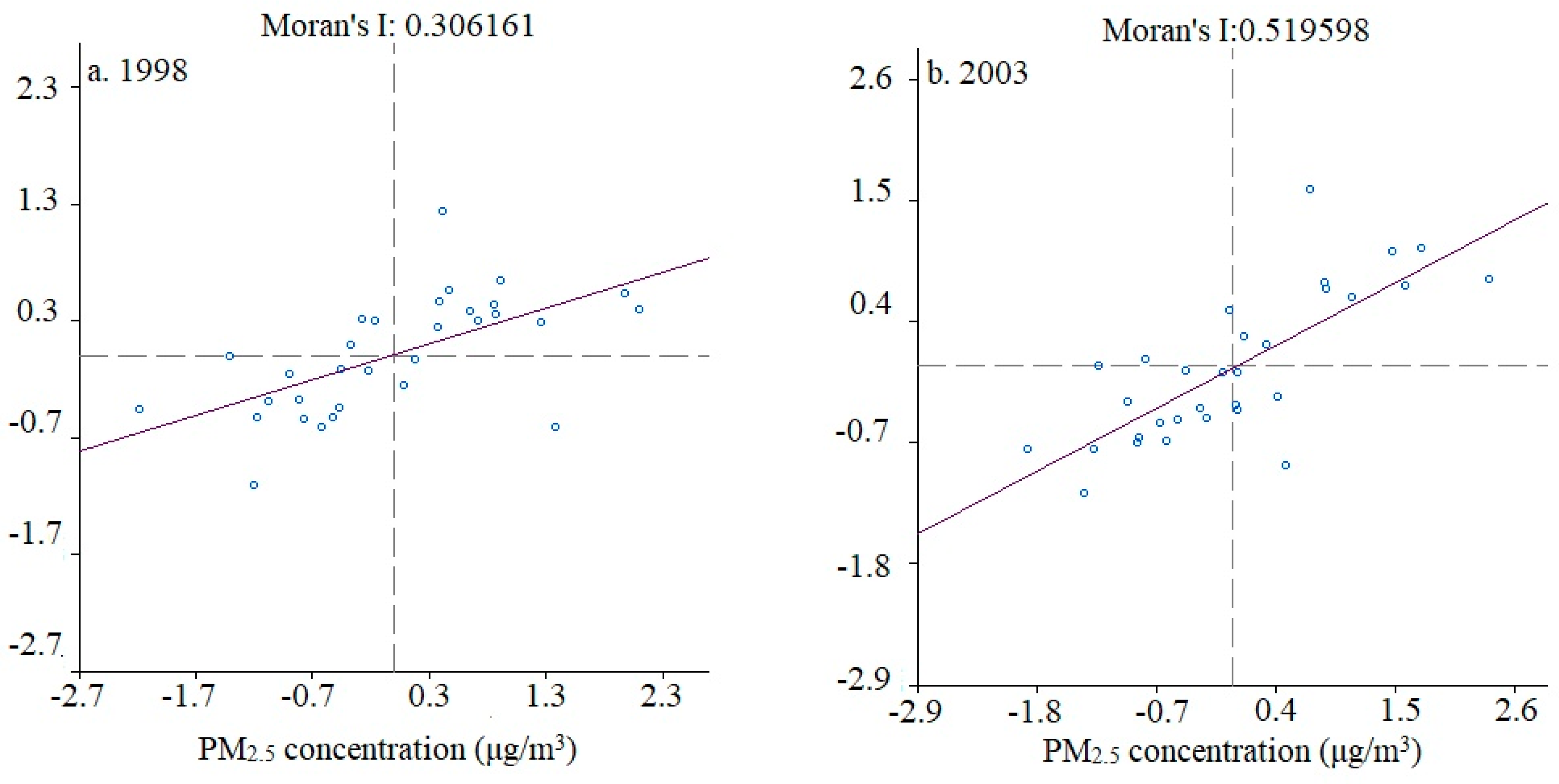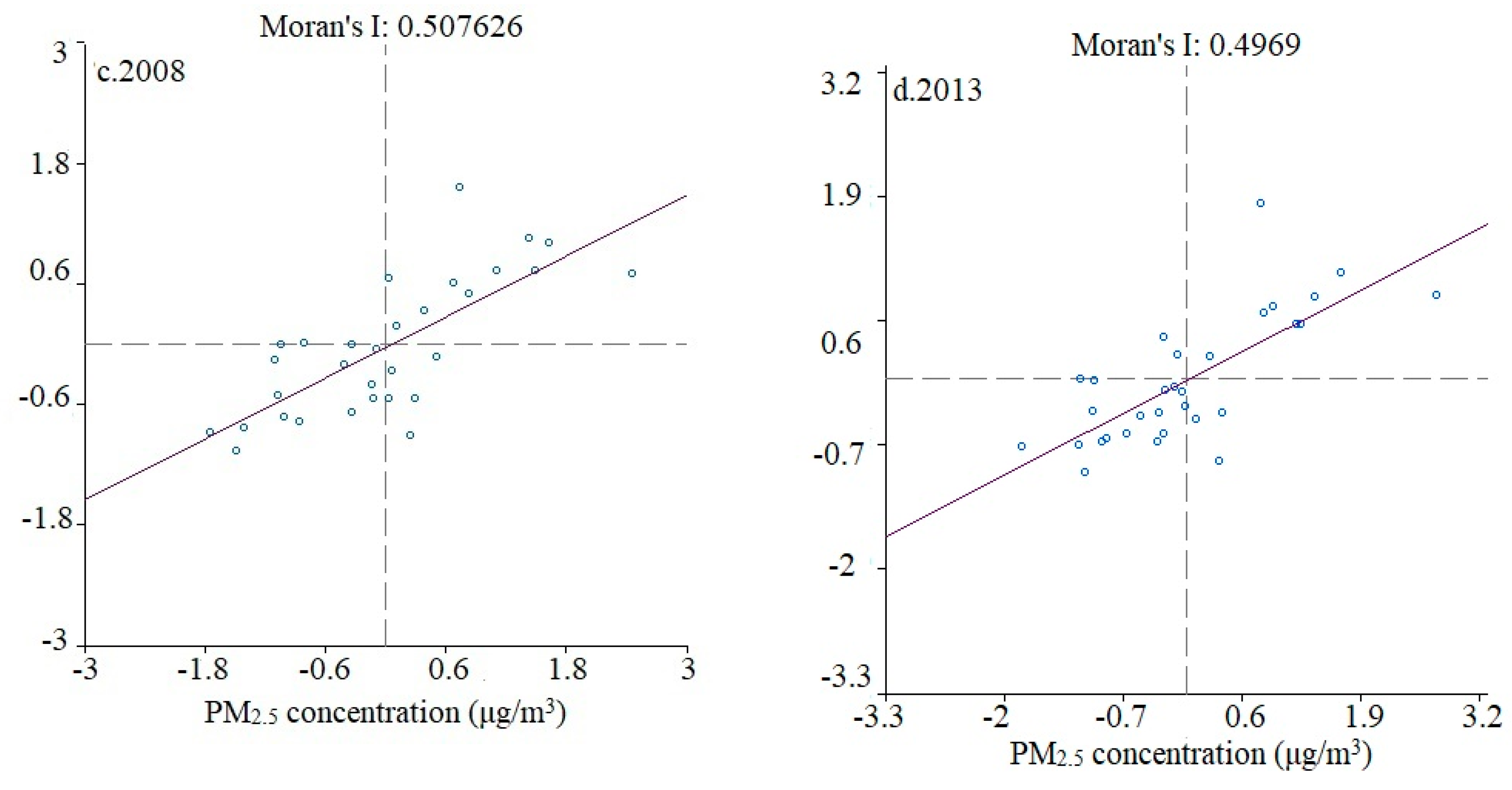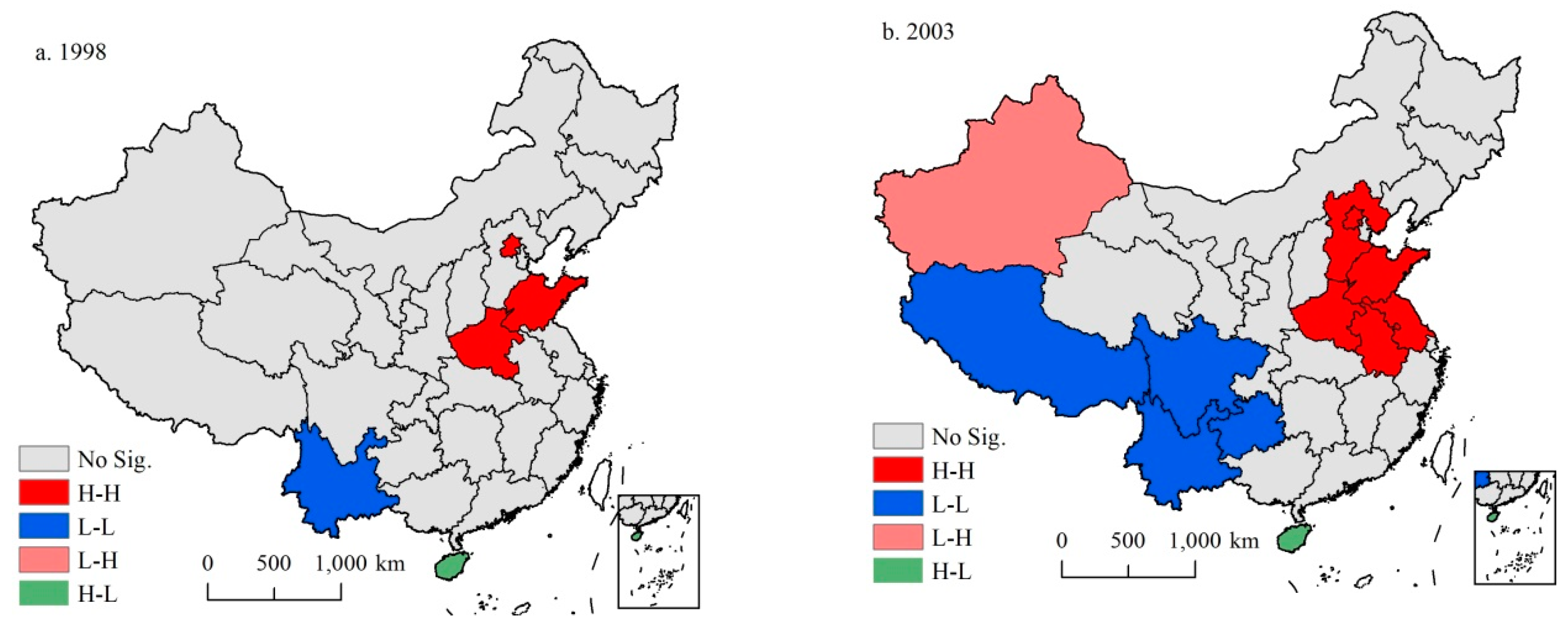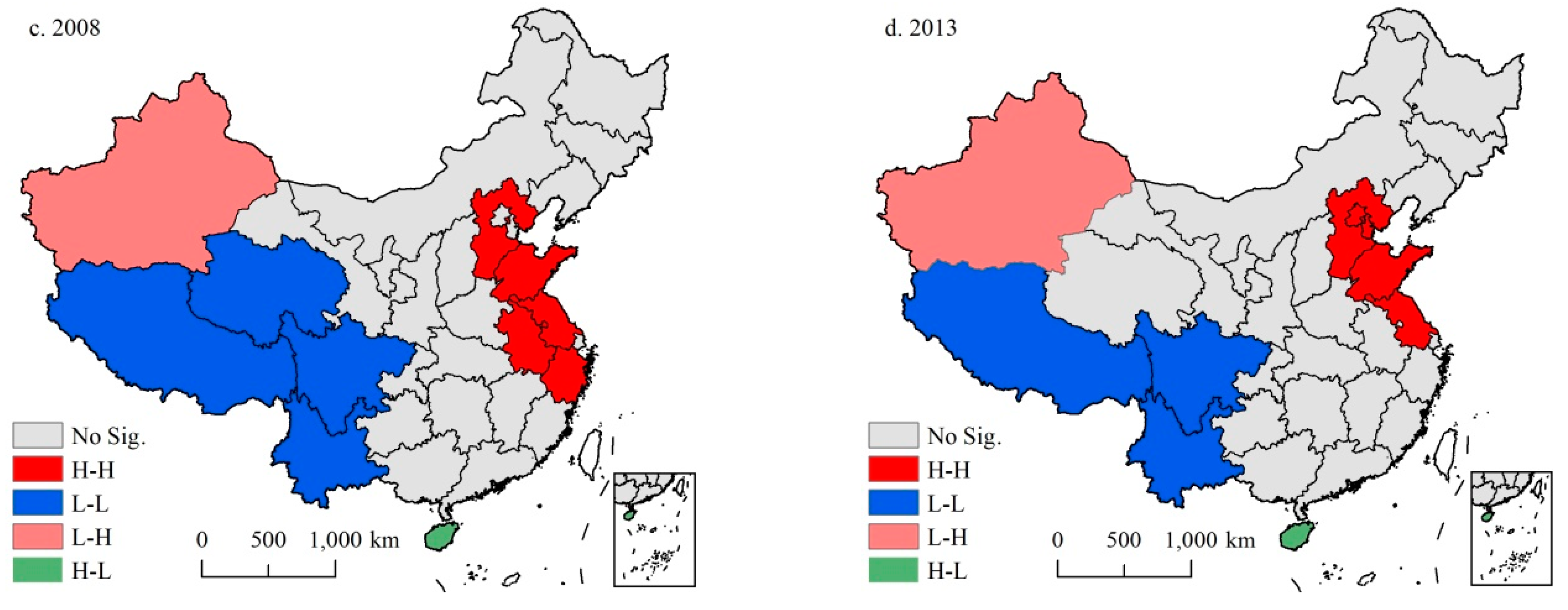1. Introduction
As the acceleration of industrialization and urbanization in recent years, air quality continues to deteriorate in China, resulting in increased threats to human health and sustainable economic development. Since 2013, several large-scale and long-duration haze incidents have taken place in China, and the whole society is now more concerned about air pollution problems, especially PM
2.5 (fine particulate matter that is 2.5 micrometers or less in diameter). PM
2.5 is rich in many toxic organic components and easily reaches the lungs when inhaled. Exposure to high PM
2.5 levels for a long time constitutes a significant health risk. Previous research has found that PM
2.5 pollution is strongly associated with many diseases, including asthma, lung cancer, and heart disease [
1,
2,
3,
4]. Research indicates that the number of premature deaths owing to outdoor air pollution is estimated to be between 350,000 and 500,000 annually in China [
5]. Premature deaths, loss of working hours, and related welfare expenses caused by air pollution have resulted in an estimated GDP loss of 10% in China [
6]. In addition, PM
2.5 pollution poses a great threat to economic growth, traffic safety, climate change, and so on [
7,
8,
9,
10,
11].
In response to the frequent occurrence of fog and haze pollution, the administrative department has formulated a series of policies to mitigate atmospheric pollution in China [
12]. For instance, the Chinese Ministry of Environmental Protection released a new Ambient Air Quality Standard in 2012, which includes a PM
2.5 concentration monitoring index for the first time and takes PM
2.5 concentration as the main control objective for improving air quality. According to the new standard, the upper limit of the average concentration of PM
2.5 is 35 μg/m
3 in China [
13]. Besides, an Action Plan for Air Pollution Prevention and Control was issued in 2013, which promises that concentration of hazardous particles including PM
2.5 will be reduced by about 10% below the 2012 level.
PM
2.5 pollution correlates not only with chemical and physical factors such as temperature, wind speed, and climate, but also with social and economic factors. Many previous studies focused on the main chemical mechanism of haze formation in China [
14,
15,
16]. However, few studies have quantitatively measured socioeconomic factors that affect PM
2.5 emissions, which remain poorly understood in China [
17,
18]. Therefore, if we are to mitigate pollution, it is crucial to identify the key anthropogenic effect factors on PM
2.5 emission. The objective of this research was to explore the causes of PM
2.5 pollution from the perspective of economic and social factors. Specifically, we applied a spatial econometric model to explore the influence of economic growth, population density, urbanization, industrialization, and energy consumption on PM
2.5 concentrations. In addition, we investigated the spatiotemporal patterns and spatial correlations of PM
2.5 pollution to provide a scientific reference for policy makers.
2. Literature Review
As is well known, the relationship between economic growth and environmental pollution has always been one of the central issues in environmental economics. Many studies have focused on this topic, and there have been some empirical tests based on the Environmental Kuznets Curve (EKC) hypothesis put forward by Grossman and Krueger [
19]. The EKC hypothesis states that there is an upside-down U-shaped relationship between pollution emission and growth—that is, at the beginning of economic developing, environmental pollution increases as income rises, but beyond a certain inflection point, pollution declines with increased income [
20]. Although some research results support the inverted U hypothesis [
21,
22,
23], other studies provide inconsistent or even opposite evidence [
24,
25,
26]. Overall, the results suggest that there may exist complicated relationship between economic growth and environmental quality.
Most of the studies on the EKC hypothesis examined the relationship between per capita GDP and different pollutants, including mainly CO
2, SO
2, NOx, CO, water pollution, and solid waste. Many studies confirm the existence of a typical upside-down U curve between environmental pollution and economic growth. For instance, Fosten et al. [
23] investigated the EKC hypothesis by using UK data and found that an upside-down U curve exists between CO
2 and SO
2 emissions and income. The empirical results of Apergis and Ozturk [
27] confirm the existence of converse-U correlativity between economic developing and CO
2 emissions for fourteen Asian countries. Lin and Liscow [
28] provided evidence supporting an inverted-U shaped curve for seven out of 11 water pollutants in China. However, some studies got different results and challenged the inverted-U hypothesis. In these studies, researchers found a variety of relationships between economic growth and pollution emission, such as a linear relationship [
29,
30], a U-shaped relationship [
31], an N-shaped relationship [
32], or even an inverted N-shaped relationship [
33]. Moreover, a few researchers find no evidence of a significant relationship between pollution emissions and economic growth. Since the conclusions depend mainly on the selection of pollutants and the choice of econometric technique, the findings provide mixed conclusions about the EKC hypothesis [
34].
To better explain the environmental impacts, subsequent empirical study on the relationship between air pollution and economic development often incorporated other socioeconomic factors than per capita income that may affect air quality. These factors, including but not limited to urbanization, energy consumption, population density, and industrial structure, have also been introduced into EKC studies. Energy consumption is often taken as an important determinant of pollution emissions. Many empirical studies confirm that higher energy consumption produces more pollution emissions [
35,
36]. Moreover, some researchers stress that rapid industrialization requires a great deal of energy consumption and, correspondingly, more pollution emissions [
37,
38]. For example, Li et al. [
39] have confirmed that the expansion of secondary industries has notable positive influence on seven pollutant emissions. Moreover, population density and urbanization are also often seen as factors affecting air quality [
38,
40]. By using the Geographical Weighted Regression (GWR) model, Fang [
41] found that population and urbanization have remarkable influence on air quality. Ma et al. [
42] also found that higher population density and rate of urbanization lead to more resource consumption and more pollution emissions, which affect environmental quality. However, the results of Luo et al. [
37] show that although urbanization is a decisive factor in pollution emission, the impact varies across regions, while population density plays a weak role. Thus, the empirical results indicate that urbanization and population density have ambiguous effects on air quality and need further research [
37].
Although there is a growing literature dealing with the EKC hypothesis for different pollutants, such as CO
2, SO
2, and NOx, researchers have paid little attention to the relationship between economic growth and PM
2.5 emission [
37,
43]. For a developing country such as China, the lack of stable and reliable long-term detection data is a major obstacle for PM
2.5 pollution research. Only in recent years has PM
2.5 concentration been monitored in China. With advances in technology, the total-column aerosol optical depth (AOD) observed by satellites can provide spatially continuous information of PM
2.5 concentrations. Moreover, existing reports seldom consider the spatial correlation and spatial spillover effects when analyzing the factors affecting air pollution [
44,
45]. In fact, haze pollution has significant spatial diffusion [
42]. Air pollution is not a simple local environmental issue but to a large extent a broader regional problem because it will spread or transfer to adjacent regions through natural factors such as atmospheric circulation, atmospheric chemical action, and economic mechanisms such as pollution leakage, industrial transfer, industrial agglomeration, and traffic flow. Therefore, the results found using some traditional econometric methods such as ordinary least square (OLS) and generalized least squares (GLS) may be invalid or biased when applied to factors affecting haze pollution. In order to effectively avoid estimation bias caused by ignoring spatial correlation, this research chooses the proper spatial panel model to study the influencing factors in the spatial spillover effect of PM
2.5 pollution.
It is also important to emphasize that China’s GDP statistical systems and accounting methods are relatively backward [
46], with some suspicion about whether official statistics are entirely reliable [
47]. Recent studies have begun to use the nighttime satellite lighting data published by the US National Oceanic and Atmospheric Administration (NOAA) to measure economic growth [
48,
49,
50]. Different from the traditional use of GDP to measure the level of economic development, satellite lighting data is not affected by regional price factors. Besides, it includes not only market economy goods and services measured by GDP but also non-market factors [
51]. Recognizing that there is some question about the authenticity of China’s statistics, this paper carries out a more robust empirical test of PM
2.5 pollution and the EKC hypothesis by using satellite lighting data as an alternative to GDP.
This study fills gaps in previous studies in the following ways. First, taking into account the spatial dependence effect of PM2.5 emission, we use the spatial panel model to investigate factors that influence PM2.5 pollution. We selected the most appropriate spatial econometric model from the three kinds of common spatial regression models. We then effectively avoid estimation error caused by ignoring spatial autocorrelation of space units. Second, in view of the doubts about the authenticity of China’s economic statistics, this paper uses nighttime lighting data of satellite monitoring as a proxy variable for economic growth, allowing for a more robust empirical test of the EKC hypothesis of PM2.5 pollution.
The balance of this article is arranged as below: Data collection and model methods are introduced in
Section 3. Results of socio-economic factors affecting haze concentration are presented in
Section 4. In a final
Section 5, we summarize our research findings and make some policy recommendations.
5. Conclusions and Implications
We have used the exploratory spatial data analysis method to examine the spatial autocorrelation of PM2.5 pollution in 31 provinces in China between 1998 and 2013 and further used the SDM model to empirically investigate the impact of socioeconomic factors on haze pollution. In this section, we summarize our conclusions and make policy recommendations.
There is a significant spatial clustering characteristic of PM2.5 pollution in China, i.e., high PM2.5 polluted areas are adjacent to other high polluted areas, and low PM2.5 polluted areas are adjacent to other low PM2.5 polluted areas. The results show that the regions with high PM2.5 concentrations are distributed in the Jing-Jin-Ji area in the north of China, the Henan province in central China, and the Shandong, Jiangsu, and Anhui provinces in eastern China. Considering the difference in PM2.5 pollution level and the characteristics of agglomeration, the government should implement a differentiated regional pollution control strategy. For the Central and Eastern regions where high PM2.5 concentrations are found, it should further strengthen comprehensive management to reduce pollution emissions. For the western regions with less haze pollution, it should raise the entry threshold for high pollution industry to prevent the risk of pollution shifted from east to west.
We found a significant positive spillover effect in China’s regional haze pollution. The increase of PM2.5 concentration in neighboring areas will aggravate haze pollution in the region. To reduce the spatial effects of air pollution, it is necessary to strengthen haze control cooperation between provincial governments. The government should establish PM2.5 pollution joint prevention, control, supervision, and coordination mechanism at the regional level, which transfers haze pollution control from local governance to regional integrated governance. Due to the “externality” of haze pollution control, cross-regional ecological compensation mechanism should be put in place to motivate participants to effectively implement cross-regional collaborative governance tasks.
Spatial econometric analysis results show that there is a significant N-shaped EKC curve between PM2.5 pollution and economic growth. Some provinces are still to the left of the second inflection point where haze pollution will increase with economic growth. The decoupling phase between haze pollution and economic growth in China has not yet come. Most of the regions will be in a phase of simultaneous increase in pollution and economic growth in the coming period. The government should implement stricter environmental regulation measures to realize the decoupling between haze pollution and economic growth as soon as possible.
Population density, not surprisingly, has strong influences on PM2.5 pollution. The higher the population density, the greater the demand for housing, home appliance, and motor vehicles, resulting in more energy consumption. Increased pollution emissions come not from these demands, from manufacturing, and also from traffic congestion. The government should attach great importance to the influence of population agglomeration on the quality of atmospheric environment. Raising the share of public transportation, the efficiency of resource use, and the sharing of pollution control and emission reduction facilities are essential measures to mitigate PM2.5 pollution in high-density population areas.
Industrial structure also affects PM2.5 concentration. Significant pollution results from secondary industry, especially heavy industry such as iron and steel, cement, etc. High-polluting industries emit large amounts of small particulate matter as well as other pollutants. As a result, one effective measure to reduce PM2.5 pollution is to adjust and optimize industrial structure. In a country with coal as the main energy source, more needs to be done to diversify energy sources and reduce dependence on coal by increasing the number of renewable and clean energy sources such as wind and solar energy. Government departments should also strengthen policy guidance for cleaner production, energy conservation, and more recycling. In addition, the government needs to provide financial and technical support and encourage human talent for resource conservation and environmental protection.
In short, this study explores the dependence of PM2.5 concentrations on economic activity and population density and provides a comprehensive insight into the economic mechanism of haze pollution in China. Furthermore, we reach policy conclusions based on our results and put forward ideas on controlling haze pollution. One of the limitations of our study is that the spatial unit analyzed is a province, a relatively large region. Given the development differences and the internal diversity in a single province, future research should identify the mechanisms generating PM2.5 based on smaller scales in China, such as at the city and county level. As a complex air pollution phenomenon, PM2.5 is affected by both climatic factors and human factors. Therefore, an estimation model including both anthropogenic factors and natural factors may be helpful in better understanding the mechanism of PM2.5 formation in future research.

